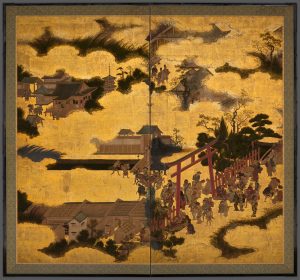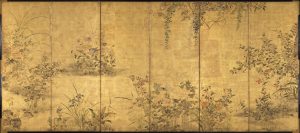This exhibition celebrates how gifts and acquisitions of the last decade have transformed The Met’s ability to narrate the story of Japanese art by both expanding and deepening the range of remarkable artworks that can meaningfully elucidate the past. Each of the ten rooms that make up the Arts of Japan Galleries features a distinct genre, school, or style, representing an array of works in nearly every medium, from ancient times to the present. Highlights include the debut of a spectacular group of contemporary metalwork by Living National Treasures and emerging artists, and, in the first rotation, a selection of woodblock prints from the Lee E. Dirks Collection.
Rotation 1: March 8–May 31, 2021
Rotation 2: June 5–August 8, 2021
Rotation 3 : August 28–December 5, 2021
Rotation 4: December 18, 2021–April 24, 2022
The exhibition is made possible by The Miriam and Ira D. Wallach Foundation Fund.

Peacocks and Cherry Blossoms; Imazu Tatsuyuki (Japanese, active early 20th century); ca.1925

Hawk on a Pine; Kano Yukinobu 狩野之信 (Japanese, ca. 1513–1575); mid-16th century

The Torii Gate of Gion Shrine; Japan; early 17th century

‘Đàn cò trong ao sen’; Yamamoto Baiitsu (1783–1856); 1852

Egrets in a Lotus Pond; Yamamoto Baiitsu (Japanese, 1783–1856); 1852

“Jūmantsubo Plain at Fukagawa Susaki,” from the series One Hundred Famous Views of Edo; Utagawa Hiroshige (Japanese, Tokyo (Edo) 1797–1858 Tokyo (Edo))

Fragrant Garden under a Hazy Moon; Nakabayashi Chikutō (Japanese, 1776–1853); 1843

“View of Mount Tenpō in Osaka” (Naniwa Tempōzan fukei); Hasegawa Sadamasu 長谷川貞升; (Japanese, active 1830s–40s)

Women’s Kabuki; Studio of Kano Takanobu (Japanese, 1571–1618); mid- to- late 1610s

A Carp Ascending a Waterfall; Shibata Zeshin (Japanese, 1807–1891); 19th century

Flowering Plants and Vegetables of the Four Seasons; Japan; early 18th century

Musk Cat; Uto Gyoshi (Japanese, active second half of 16th century); mid–late 16th century
Source: The Met







